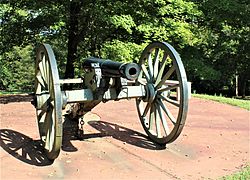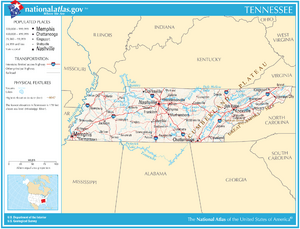Battle of Riggins Hill facts for kids
Quick facts for kids Battle of Riggins Hill |
|||||||
|---|---|---|---|---|---|---|---|
| Part of the American Civil War | |||||||
 Civil War replica cannon at Fort Defiance in Clarksville |
|||||||
|
|||||||
| Belligerents | |||||||
| Commanders and leaders | |||||||
| William Warren Lowe | Thomas Woodward | ||||||
| Strength | |||||||
| 1,100 | 700 | ||||||
| Casualties and losses | |||||||
| negligible | 107 | ||||||
The Battle of Riggins Hill happened on September 7, 1862. It was a small but important fight in western Tennessee during the American Civil War. A group of Confederate soldiers, led by Colonel Thomas Woodward, had taken over Clarksville, Tennessee. This threatened Union boats on the Cumberland River. Union soldiers, led by Colonel William Warren Lowe, came from Fort Donelson. They fought the Confederates for less than an hour. The Union forces won, pushing the Confederates away. This battle was part of a bigger plan called the Confederate Heartland Offensive. But its main impact was on the local area around Clarksville.
Contents
Why the Battle Happened: The Background
Protecting the Rivers
In 1861, during the Civil War, Confederates built forts near Clarksville, Tennessee. These forts were on the Cumberland River. They protected important railroad bridges. By early 1862, there were two forts: Fort Sevier and Fort Clarke. They had cannons to guard the river.
Union Takes Control
In February 1862, Union General Ulysses S. Grant captured Fort Donelson. This forced the Confederates to leave Kentucky and much of Tennessee. On February 19, Union boats sailed up the Cumberland River. They found the forts empty. Union soldiers then took over Clarksville without a fight. Soon after, they also took Nashville, the state capital. Fort Sevier was renamed Fort Defiance. It was made bigger and guarded by Union soldiers.
Confederate Raids and Plans
During the summer of 1862, Confederate forces tried to strike back.
- On July 4, John Hunt Morgan led 900 Confederate cavalry (soldiers on horseback). They raided Kentucky, capturing Union troops and supplies. This raid made President Abraham Lincoln worried.
- On July 13, Nathan Bedford Forrest and his cavalry forced Union soldiers to surrender in Murfreesboro. They also destroyed food supplies and railroad bridges. This made it harder for Union armies to get what they needed.
- These raids were part of a bigger plan. Confederate generals like Edmund Kirby Smith and Braxton Bragg wanted to invade Kentucky. They hoped many Kentuckians would join their army. This big plan was called the Confederate Heartland Offensive.
The Battle of Riggins Hill
Clarksville is Captured
In July and August 1862, there was a lot of fighting around Clarksville. On August 18, Confederate Colonel Thomas Woodward and his soldiers captured Clarksville. The Union commander, Colonel Rodney Mason, surrendered easily. He was later punished for this.
Union Soldiers Advance
On September 5, 1862, a Union force of 1,100 men left Dover, Tennessee. They were led by Colonel William W. Lowe. Their mission was to take back Clarksville. Lowe's force included soldiers from different regiments. They also had artillery (cannons).
The Fight at Riggins Hill
On September 6, Lowe's Union troops started fighting Woodward's Confederates. The Confederates tried to slow them down. On September 7, Woodward's 700 defenders took positions on a ridge called Riggins Hill. They hid behind houses, fences, and trees. This spot is now on U.S. Route 79.
Lowe's Union troops set up on a ridge nearby. They started firing their cannons at the Confederates. After about 45 minutes, the Confederates began to weaken. Union soldiers then pushed forward from the sides. The Confederates ran away. Union cavalry chased them through Clarksville. Woodward's force lost 17 killed, 40 wounded, and about 50 captured. The Union forces had very few losses.
What Happened Next
After the battle, Lowe's soldiers took control of Clarksville. This reopened the Cumberland River for Union boats. However, the Union didn't have enough soldiers to stay in Clarksville right away. It wasn't fully occupied until December 1862. Confederate raids continued in the area until the end of 1864.
Historical Markers
You can find a special marker for the Battle of Riggins Hill in Clarksville. It is located on U.S. Route 79 at Magnolia Drive. There are also other markers nearby. These tell about Fort Defiance, Fort Sevier, and Trice's Landing.
Images for kids



